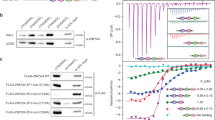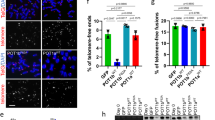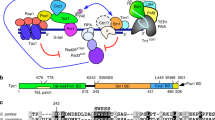Abstract
The mammalian shelterin component TPP1 has essential roles in telomere maintenance and, together with POT1, is required for the repression of DNA damage signaling at telomeres. Here we show that in Mus musculus, the E3 ubiquitin ligase Rnf8 localizes to uncapped telomeres and promotes the accumulation of DNA damage proteins 53Bp1 and γ-H2ax. In the absence of Rnf8, Tpp1 is unstable, resulting in telomere shortening and chromosome fusions through the alternative nonhomologous end-joining (A-NHEJ) repair pathway. The Rnf8 RING-finger domain is essential for Tpp1 stability and retention at telomeres. Rnf8 physically interacts with Tpp1 to generate Ubc13-dependent Lys63 polyubiquitin chains that stabilize Tpp1 at telomeres. The conserved Tpp1 residue Lys233 is important for Rnf8-mediated Tpp1 ubiquitylation and localization to telomeres. Thus, Tpp1 is a newly identified substrate for Rnf8, indicating a previously unrecognized role for Rnf8 in telomere end protection.
This is a preview of subscription content, access via your institution
Access options
Subscribe to this journal
Receive 12 print issues and online access
$189.00 per year
only $15.75 per issue
Buy this article
- Purchase on Springer Link
- Instant access to full article PDF
Prices may be subject to local taxes which are calculated during checkout






Similar content being viewed by others
References
de Lange, T. How shelterin solves the telomere end-protection problem. Cold Spring Harb. Symp. Quant. Biol. 75, 167–177 (2010).
Wang, F. et al. The POT1–TPP1 telomere complex is a telomerase processivity factor. Nature 445, 506–510 (2007).
Xin, H. et al. TPP1 is a homologue of ciliate TEBP-beta and interacts with POT1 to recruit telomerase. Nature 445, 559–562 (2007).
Deng, Y., Guo, X., Ferguson, D.O. & Chang, S. Multiple roles for MRE11 at uncapped telomeres. Nature 460, 914–918 (2009).
Denchi, E.L. & de Lange, T. Protection of telomeres through independent control of ATM and ATR by TRF2 and POT1. Nature 448, 1068–1071 (2007).
Guo, X. et al. Dysfunctional telomeres activate an ATM-ATR-dependent DNA damage response to suppress tumorigenesis. EMBO J. 26, 4709–4719 (2007).
Rai, R. et al. The function of classical and alternative non-homologous end-joining pathways in the fusion of dysfunctional telomeres. EMBO J. 29, 2598–2610 (2010).
Guirouilh-Barbat, J., Rass, E., Plo, I., Bertrand, P. & Lopez, B.S. Defects in XRCC4 and KU80 differentially affect the joining of distal nonhomologous ends. Proc. Natl. Acad. Sci. USA 104, 20902–20907 (2007).
Weinstock, D.M., Brunet, E. & Jasin, M. Formation of NHEJ-derived reciprocal chromosomal translocations does not require Ku70. Nat. Cell Biol. 9, 978–981 (2007).
Harper, J.W. & Elledge, S.J. The DNA damage response: ten years after. Mol. Cell 28, 739–745 (2007).
Al-Hakim, A. et al. The ubiquitous role of ubiquitin in the DNA damage response. DNA Repair (Amst.) 9, 1229–1240 (2010).
Wang, B. & Elledge, S.J. Ubc13/Rnf8 ubiquitin ligases control foci formation of the Rap80/Abraxas/Brca1/Brcc36 complex in response to DNA damage. Proc. Natl. Acad. Sci. USA 104, 20759–20763 (2007).
Mailand, N. et al. RNF8 ubiquitylates histones at DNA double-strand breaks and promotes assembly of repair proteins. Cell 131, 887–900 (2007).
Kolas, N.K. et al. Orchestration of the DNA-damage response by the RNF8 ubiquitin ligase. Science 318, 1637–1640 (2007).
Huen, M.S. et al. RNF8 transduces the DNA-damage signal via histone ubiquitylation and checkpoint protein assembly. Cell 131, 901–914 (2007).
Plans, V. et al. The RING finger protein RNF8 recruits UBC13 for lysine 63-based self polyubiquitylation. J. Cell. Biochem. 97, 572–582 (2006).
Peuscher, M.H. & Jacobs, J.J. DNA-damage response and repair activities at uncapped telomeres depend on RNF8. Nat. Cell Biol. 13, 1139–1145 (2011).
Ito, K. et al. N-Terminally extended human ubiquitin-conjugating enzymes (E2s) mediate the ubiquitination of RING-finger proteins, ARA54 and RNF8. Eur. J. Biochem. 268, 2725–2732 (2001).
O'Connor, M.S., Safari, A., Xin, H., Liu, D. & Songyang, Z. A critical role for TPP1 and TIN2 interaction in high-order telomeric complex assembly. Proc. Natl. Acad. Sci. USA 103, 11874–11879 (2006).
Jin, J. et al. SCFbeta-TRCP links Chk1 signaling to degradation of the Cdc25A protein phosphatase. Genes Dev. 17, 3062–3074 (2003).
Jin, J., Li, X., Gygi, S.P. & Harper, J.W. Dual E1 activation systems for ubiquitin differentially regulate E2 enzyme charging. Nature 447, 1135–1138 (2007).
Centore, R.C. et al. CRL4(Cdt2)-mediated destruction of the histone methyltransferase Set8 prevents premature chromatin compaction in S phase. Mol. Cell 40, 22–33 (2010).
Peng, J. et al. A proteomics approach to understanding protein ubiquitination. Nat. Biotechnol. 21, 921–926 (2003).
Newton, K. et al. Ubiquitin chain editing revealed by polyubiquitin linkage-specific antibodies. Cell 134, 668–678 (2008).
Lok, G.T., Dong, S.S., Thomson, T.M. & Huen, M.S. Differential regulation of RNF8-mediated Lys48-and Lys63 based poly-ubiquitylation. Nucleic Acids Res. published online, doi:10.1093/nar/gkr655 (16 September 2011).
Sobhian, B. et al. RAP80 targets BRCA1 to specific ubiquitin structures at DNA damage sites. Science 316, 1198–1202 (2007).
Zhao, G.Y. et al. A critical role for the ubiquitin-conjugating enzyme Ubc13 in initiating homologous recombination. Mol. Cell 25, 663–675 (2007).
Hockemeyer, D. et al. Telomere protection by mammalian Pot1 requires interaction with Tpp1. Nat. Struct. Mol. Biol. 14, 754–761 (2007).
Kibe, T., Osawa, G.A., Keegan, C.E. & de Lange, T. Telomere protection by TPP1 is mediated by POT1a and POT1b. Mol. Cell. Biol. 30, 1059–1066 (2010).
Huang, T.T. & D'Andrea, A.D. Regulation of DNA repair by ubiquitylation. Nat. Rev. Mol. Cell Biol. 7, 323–334 (2006).
Chang, W., Dynek, J.N. & Smith, S. TRF1 is degraded by ubiquitin-mediated proteolysis after release from telomeres. Genes Dev. 17, 1328–1333 (2003).
Atanassov, B.S. et al. Gcn5 and SAGA regulate shelterin protein turnover and telomere maintenance. Mol. Cell 35, 352–364 (2009).
Zeng, Z. et al. Structural basis of selective ubiquitination of TRF1 by SCFFbx4. Dev. Cell 18, 214–225 (2010).
Her, Y.R. & Chung, I.K. Ubiquitin ligase RLIM modulates telomere length homeostasis through a proteolysis of TRF1. J. Biol. Chem. 284, 8557–8566 (2009).
Lee, T.H., Perrem, K., Harper, J.W., Lu, K.P. & Zhou, X.Z. The F-box protein FBX4 targets PIN2/TRF1 for ubiquitin-mediated degradation and regulates telomere maintenance. J. Biol. Chem. 281, 759–768 (2006).
Fujita, K. et al. Positive feedback between p53 and TRF2 during telomere-damage signalling and cellular senescence. Nat. Cell Biol. 12, 1205–1212 (2010).
Flynn, R.L. et al. TERRA and hnRNPA1 orchestrate an RPA-to-POT1 switch on telomeric single-stranded DNA. Nature 471, 532–536 (2011).
Wu, L. et al. Pot1 deficiency initiates DNA damage checkpoint activation and aberrant homologous recombination at telomeres. Cell 126, 49–62 (2006).
Hoeller, D., Hecker, C.M. & Dikic, I. Ubiquitin and ubiquitin-like proteins in cancer pathogenesis. Nat. Rev. Cancer 6, 776–788 (2006).
Bernassola, F., Karin, M., Ciechanover, A. & Melino, G. The HECT family of E3 ubiquitin ligases: multiple players in cancer development. Cancer Cell 14, 10–21 (2008).
Nakayama, K.I. & Nakayama, K. Ubiquitin ligases: cell-cycle control and cancer. Nat. Rev. Cancer 6, 369–381 (2006).
Li, L. et al. Rnf8 deficiency impairs class switch recombination, spermatogenesis, and genomic integrity and predisposes for cancer. J. Exp. Med. 207, 983–997 (2010).
Augereau, A. et al. Telomeric damage in early stage of chronic lymphocytic leukemia correlates with shelterin dysregulation. Blood 118, 1316–1322 (2011).
Else, T. et al. Genetic p53 deficiency partially rescues the adrenocortical dysplasia phenotype at the expense of increased tumorigenesis. Cancer Cell 15, 465–476 (2009).
Morales, J.C. et al. Role for the BRCA1 C-terminal repeats (BRCT) protein 53BP1 in maintaining genomic stability. J. Biol. Chem. 278, 14971–14977 (2003).
Tevethia, M.J. & Ozer, H.L. SV40-mediated immortalization. Methods Mol. Biol. 165, 185–199 (2001).
Rai, R. & Chang, S. Probing the telomere damage response. Methods Mol. Biol. 735, 145–150 (2011).
Multani, A.S. & Chang, S. Cytogenetic analysis of telomere dysfunction. Methods Mol. Biol. 735, 139–143 (2011).
Campanero, M.R. & Flemington, E.K. Regulation of E2F through ubiquitin-proteasome-dependent degradation: stabilization by the pRB tumor suppressor protein. Proc. Natl. Acad. Sci. USA 94, 2221–2226 (1997).
Acknowledgements
We are grateful to J. Karlseder (Salk Institute) for providing anti-mouse Trf1 and Trf2 antibodies, to Z. Songyang (Baylor College of Medicine) for providing anti-human TPP1 antibody and TPP1 cDNA constructs and to D. Durocher (Samuel Lunenfeld Research Institute) for providing mouse Rnf8 and Rnf8 mutant cDNAs. The linkage-specific antibodies to Lys63 and Lys48 ubiquitin conjugates were provided by V.M. Dixit (Genentech), and pLPC-hRAP1 was a gift from M. Lei (University of Michigan Medical School). We would like to thank A. Multani (MD Anderson Cancer Center) for help with chromosome analysis and I. Patanam for technical support. S.C. acknowledges generous financial support from the National Cancer Institute (RO1 CA129037) and the Michael and Betty Kadoorie Cancer Genetic Research Program. J.J. is a Pew Scholar and is supported by a grant (AU-1711) from the Welch Foundation.
Author information
Authors and Affiliations
Contributions
R.R., J.J. and S.C. conceived the project and designed the experiments. R.R., J.J., J.-M.L. and H.Z. conducted the experiments and generated data for the figures. Y.D. generated anti-mouse Tpp1 antibody. J.C. provided the Rnf8−/− mice and anti-human RNF8 antibody. M.S.-Y.H. and G.T.-M.L. provided human RNF8 cDNAs and shared unpublished results. R.R., J.J. and S.C. analyzed and interpreted the data. R.R. and S.C. created the figures and wrote the paper.
Corresponding author
Ethics declarations
Competing interests
The authors declare no competing financial interests.
Supplementary information
Supplementary Text and Figures
Supplementary Figures 1–8 (PDF 1394 kb)
Rights and permissions
About this article
Cite this article
Rai, R., Li, JM., Zheng, H. et al. The E3 ubiquitin ligase Rnf8 stabilizes Tpp1 to promote telomere end protection. Nat Struct Mol Biol 18, 1400–1407 (2011). https://doi.org/10.1038/nsmb.2172
Received:
Accepted:
Published:
Issue Date:
DOI: https://doi.org/10.1038/nsmb.2172
This article is cited by
-
RING finger protein 13 protects against nonalcoholic steatohepatitis by targeting STING-relayed signaling pathways
Nature Communications (2023)
-
CAMK2D serves as a molecular scaffold for RNF8-MAD2 complex to induce mitotic checkpoint in glioma
Cell Death & Differentiation (2023)
-
A functional reference map of the RNF8 interactome in cancer
Biology Direct (2022)
-
RNF8 up-regulates AR/ARV7 action to contribute to advanced prostate cancer progression
Cell Death & Disease (2022)
-
Pellino1 regulates reversible ATM activation via NBS1 ubiquitination at DNA double-strand breaks
Nature Communications (2019)



